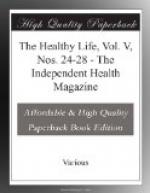In dealing with this vitally important question, we shall most of us, I take it, agree upon certain points. In the light of recent knowledge upon, and extended experience of the subject, one such point which now appears incontrovertible is that there are thousands die annually—directly or indirectly—through overfeeding where one dies through insufficient nourishment. And it may at once be said that, as regards these thousands, the death certificates are practically valueless as data in relation to erroneous dieting, so that in this way we can never get at a correct estimate as to the actual number of deaths due to overfeeding. Bright’s disease, gastric and intestinal affections, growths of various kinds, cancer, etc., are each in their turn certified as the “Cause of Death.” Most often, however, the initial cause is the overloading of the system with an amount of food beyond that which is necessary or healthful—and thereby clogging up the tissues, the organs and smaller bloodvessels.
But it may be said: “How can you substantiate such a general and sweeping statement?” In the first place—and this is profoundly significant—other things being equal, it must be acknowledged by all unbiased people that the small and moderate feeders do not contract disease in anything like the proportion that big feeders do, and as a natural consequence live longer lives.
Further, it must surely be quite evident by this time that there is a sufficiently large enough number of people who are thus existing in good health—and steadily regaining it where it has been lost—on the lines of moderate feeding. And the number is accumulating at a rapid pace; more and more are coming into line with those of us who, having thus found health in themselves, their patients and friends, are preaching the practice of two meals a day, and sometimes only one where there is serious organic disease to combat—thus defying the dicta of those eminent physiologists who “settled” the question years ago.
Now I quite admit—it would be impertinence to do otherwise—that “M.D.’s” statements and views must not be ignored, must indeed be respected. And he tells us that he “heard of,” in one day, three cases which “went wrong” through underfeeding; well, for those three cases we can point to hundreds who are going right through eating just enough and not too much. I am prepared, on the other hand, to admit the danger of a continued semi-starvation diet; our difficulty is to define in each individual case what exactly would be a semi-starvation, and what a sufficient diet. It is impossible to have a fixed standard for everybody. After all, “the proof of the pudding is in the eating”; often it is a matter of experimenting for some little time, and in this way we could judge largely of the result of our dieting by our state of general health.
On some main points of the question I am now
absolutely
convinced—viz.:




